home |
electronics |
toolbox |
science club |
tuxtalk |
photos |
e-cards |
online-shop

Ice dams, attic temperatures and insulation
Most people in the world will think of home insulation only
in terms of energy savings. However those that live in very cold
and extreme climates have other concerns too. Heat leaking onto
your roof can damage the house.
Attic ventilation
I am providing here a bit of background information because
this is a very Canadian problem and mostly unknown to people
in less extreme climates such as e.g Europe. The temperature
difference between summer and winter are here about 70'C. The
summers are very warm and the winters cold. To live comfortable
in those extremes we have heatings systems that use air.
Such a forced air system allows you to both heat and cool
the house using the same air ducts. The attic
is not an extra room that could be used for storage. The attic
is only for ventilation and insulation of the home.
The roof has a vent at the top and metal plates with
small holes known as soffits function as air intakes. The insulation
does not sit directly under the roof. Its on the attic floor and
there is a lot of insulation. Typically 30cm to 40cm of glas fiber wool.
The air flow in the attic is supposed to look like this:

How attic ventilation is supposed to work
Older homes might have other air flow patterns such as vents on the sides of the house. Soffits and air vents on top of the roof (ridge vents) are however the most effective way of venting the attic. Almost all new homes in cold climates are built like that.
A cold attic and a cold roof
The main point of this type of ventilation is to keep the roof
cool in winter. It has as well the added effect that the building
material can breath. Should ever any drop of water or condensation
or humid air
get in then it can evaporate again and escape through the vents.
Glas fiber wool is excellent for this application because it can
breath too and does not trap water.
By keeping the roof surface cold we are trying to prevent the snow on top
of the roof from melting.
The snow remains often a powder
and wind will blow some of it off after a couple of days.
This prevents excessive snow accumulation on the roof and
"ice damming" at the same time.
Note that this kind of attic ventilation works well in cold and mainly
dry climates. It can not be used in hot areas with a lot of humidity for
long periods of time.
What are ice dams?
Of course in reality there could be all kinds of reasons
why the attic ventilation and insulation does not work as expected. Many factors play
a role and I get to those in the troubleshooting section.
Let's first understand what ice dams are and why you should care.
If the attic is warm enough to melt some of the snow on top of the roof then
the warm water will run down below the snow towards the eaves.
The eaves are always cold and the water will freeze again.
A block of ice forms. The block of ice is normally below the snow
and difficult to see but in most cases houses with ice dams
will as well have icicles and they are easy to see.
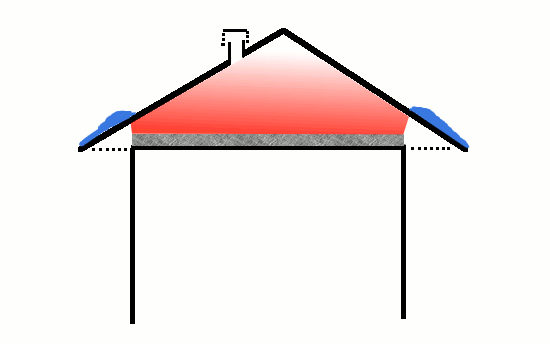
Ice dams on the eaves (the snow
on top of the roof is not shown).
When the weather gets later in the season much
warmer then all the snow will melt. A big puddle can form
behind the ice dam.
Roofs with a slope and shingles work only if the water can
run down the roof. Standing water on such a roof will back-up
behind the shingles and run into the attic and from there it
can run into the house, stain the walls and cause other damage. The amount of damage depends
on the amount of water that enters the home.
How cold should the attic be?
This is the main reason why I wrote this article. I could not find
any information as to how cold and attic should be for it to
work properly. If you try to find informaiton on this subject you
will find many posts from people that think that the attic
will have the same temperature as outside once it's ventilated.
That is obviously wrong. Anybody with an unheated garage attached
to the house will know that it is most of the time above freezing
in that garage even when the garage window is slightly open to
allow for ventilation. There will always be some heat leak from
the house into the attic and it is important to have the attic a bit warmer otherwise
condensation and mold would form.
My home had problems with ice dams for
many years and it took me a while to fix them. I had
sensors installed in the attic to monitor what was going on.
This allowed me to collect data, something that nobody seems to have done
before.
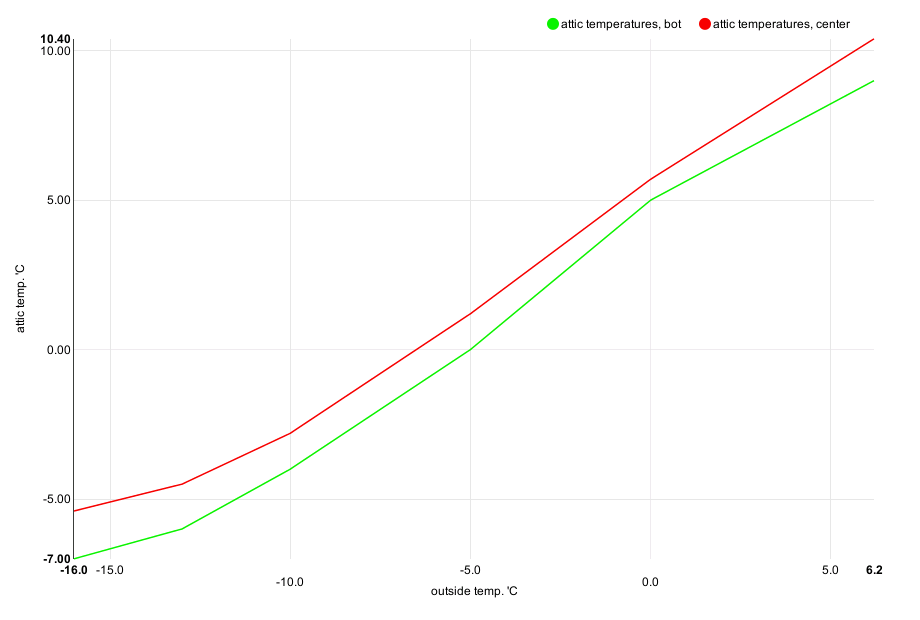
Attic temperatures as a function of the outside
temperature.
Red: temperature at the top near the ridge of the roof.
Green: about half way between ridge and eaves. All temperaturs in 'C.
The above graph shows temperatures at a point where I had the insulation
just good enough to prevent ice dams. This is the limit. In general you
want to have a slightly colder attic but this would be just good enough.
The curve is approximately linear down to -10'C. Theoretically it should
be totally linear. I am not sure what the non-linear effect is. You can use the following formula
to calculate the max. attic temperature (Ta) given a known outside temperature (Toutside).
|
Attic temperature calculator
|
Ta = 5 + 11/13 * Toutside
The formula is valid for outside temperatures from
around 0'C down to -10'C. All temperatures in 'C.
An attic temperature lower than Ta is better.
However your attic should alwasy be at least a degree warmer than the outside
to avoid mold and condensation in wet weather conditions.
The above measurements were done using a roof with a slope of 1/3 (roofers call this for some reason a 4/12 slope).
Ice dams are obviously less of a concern the more slope you have since a higher
slope will reduce the size of the water puddles that can form behind an ice dam.
The temperature measurements where always taken on days with
no wind. Strong winds can influence the temperature in vented attics
significantly.
Climate/Weather conditions: Temperatures are throughout the winter
below -5'C with the exception of very few days. Those periods with
daytime temperatures above -4'C are no longer than 3 days.
What does an ice dam look like?
Most ice dams are not visible because they are forming below a cover
of snow. It's however possible to see the actual ice in special
weather conditions where not a lot of snow has fallen and most of the
snow did already melt. The big block of ice will melt last and you
can see it.

An ice dam, visible after a few warm days. The dam melts last.
Icicles hanging from your gutters are normally the only way to know
that you have an ice dam. The icicles fall off first when the snow
starts to melt and the ice dam disappears last.
Ice dam troubleshooting, find the cause
Most contractors will tell you that you just need to add more insulation
and improve the ventilation of the attic. It sounds simple but the problem
might have other causes. It is alwasy nice to get "expert advice" but
in the end there is nobody that knows your house better than you. You
are observing it throughout the year and in different weather conditions.
Nobody will be a better expert than you, the home owner. You can find the
cause of the problem if you keep your
eyes open and observe carefully. Here are is a list of things to investigate.
Ventilation problems
- Are your soffits acutally functioning and can the air get intro the
attic?
- Is the insulation inside the attic too high and therefore blocking
the air near the eaves? -> You can buy styro-foam rafter vents that
can guide the air along the bottom of the roof.
- Was spray-in insulation (loose glas fiber or cellulose/paper) used in the attic? If yes then take an
inspection camera and look from inside onto the soffits. Your contractor might
have been spraying all over the place and did accidently put a nice layer
of insulation on the inside of the soffits which reduces the efficency of those
soffits.
- In older houses where soffits had been retro-fitted: Are the soffits
really open or is there a board behind them with just a few small openings
in the board?
- How can the air get out of the attic? You should have
"Maximum"-vents on top of the roof for optimal ventilation. Older houses might be ventilated
on the sides. Those side vents can not be combined with vents on the
top of the roof since this would just short circuit the air flow.
Ventilation is however only in very few situations the cause of the problem. You don't need
much ventilation if you have proper insulation.
Heat leaks and insulation problems
- More insulation is not always better. With glass fiber insulation
you need in Canada a layer of about 30cm to 40cm. If you have already
about 30cm and you get icicles then adding more insulation is not going
after the root cause of the problem.
- Can air from the rooms below the attic leak into the attic?
- Are electrical boxes where lights are installed in the rooms below
properly covered? Pot lights are especially a concern and they might
guide a lot of warm air from the living space into the attic.
Those electrical boxes and pot lights can be covered with an air tight box or wraped with aluminum foil.
- Is the access to the attic (hatch) air tight and insulated?
- Is the vapor barrier damaged? This is a polyethylene foil below the insulation. It's a common problem that contractors doing renovation work damage that foil but forget to repair it. A special permanently sticking tape must be used to repair the foil.
- Can air from the heating system leak into the attic?
- Do you have heating ducts leaking air into the attic?
- Are the air vents properly installed in the ceiling or can they blow air into the attic ? (see further down for an example from my house).
- Go on a cold day with an infrared thermometer into the attic
and check the surface temperature of the insulation around the heating
ducts to find leaks. Even better if you can get an infrared camera but they
are very expensive.
- Can air from bath-room vents leak into the attic?
Can I use an infrared thermal imaging camera to locate the problem?
Infrared cameras are very good to locate surface temperature differences.
Snow is a good insulation material and the surface temperature does
not change much when the temperature further down changes. Large ice dams form
only when some snow deep down melts because the upper layers of snow trap
the heat. The top snow layers don't really change their temperature in any
significant way. If there is no snow on the roof then the temperature
differences will be very small since most heat can radiate immendiately (the
insulating snow layer is missing).
In other words thermal imaging will only spot a huge problem when
used on the outside of the house. Here is the same area where you saw
the ice dam in the photo further up shown on a infrared camera.
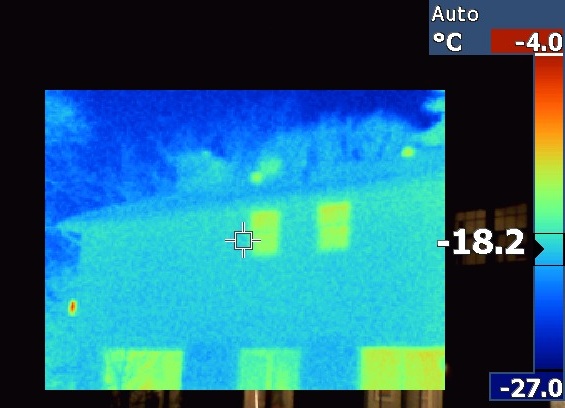
infrared image of the area prone to ice dams, you don't see anything suspicious.
As you can see the infrared thermal imaging is not capable of locating
heat loss when used on the outside of the house because the temperature
differences are very small. If you want to see those heat patters
on your roof then you have to wait for a day in fall or early spring where
the roof is just covered with a very thin layer of snow and the outside
temperature is just around zero. On those days you will then see a snow
pattern that corresponds to the heat pattern and you are looking for areas
where the snow melts faster. With the right weather conditions you will even be able
to see the rafters below your roof. Very tiny temperature differences become visible. No special equipment needed.

Heat loss pattern visible with a thin layer of snow on the roof on a "warm winter day".
Infrared thermal imaging is not very useful to locate ice dams on the outside of
the house but you can locate the problem by using such a camera on a cold winter
day on the inside of the attic.
It allows you to find the areas where you have heat leaks below the
insulation. Here is a nice example. The camera is looking towards
the eaves. You see heat leaking through the insulation just below the
styro foam baffle.

Just in front you see between the rafters a styro foam baffle and there is a heat leak visible on the insulation below the baffle.
Heating ducts in the attic
It is not the best idea to put the heating ducts into
the attic since there is always a chance that they leak air but
it is commonly done because it is easy to install them in the attic.
Glas fiber wool insulation can not seal a stream of hot air.
It is complicated to fix this situation but it can be done.
I have heating ducts in the attic and that
is why I worked on this problem over several seasons and I managed
to fix the problem such that I will only get very small ice dams
from time to time and in most winters, especially the colder
ones, I will have none.
You need to find all the leaking joints on your ducts. The most
efficient way to find them is to use an infrared camera. Get such
a camera on a cold winter day and climb up in your attic.
Take notes of all the leaks and mark them.
When it is a little bit warmer (not too warm) you go back into
your attic. You dig the ducts form under the insulation in the previously
marked spots and you fix the leaking joints with aluminum duct tape.
Don't use plastic duct tape. It does not last.
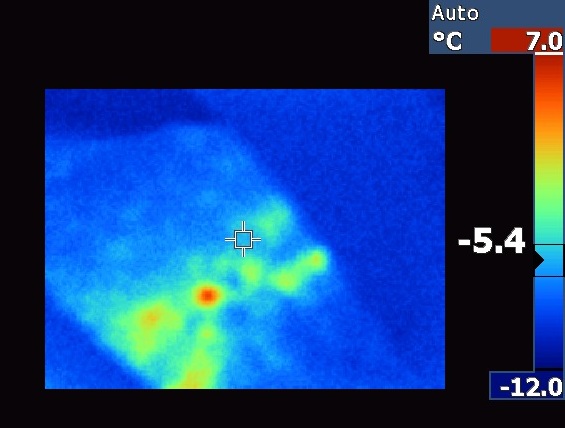
A duct joint leaking air from under the insulation.
While doing the survey with the infrared camera you will as well see
ducts that have too little insulation around them. They are not leaking
but they are too high above the attic floor and the insulation around them
is too thin. Top-up the insulation around those ducts.
I needed two seasons to fix everything. In the first winter I searched for
leaks. Towards the end of that winter, when it is more comfortable
to work in the attic, I fix those leaks and I toped-up insulation where
needed. In the next winter I went back to check again. I fix any remaining
problems. You need multiple seasons because the infrared camera shows
the leaks only on very cold days. It does not see anything if the background
temperature is too high. It would be like taking a photo of a white
paper on a white background. Such a photo would not be very good. You need
a different background color.
Heat leaking from the living space into the attic
The most common cause of ice dams despite "proper insulation" is
a heat leak from the living space. It can be a small hole of some
kind. Here is a case where the hot air vent from the heating
system is located in the ceiling. It is already suspicious
to see no mouting screws on the sides. Somebody did a quick
job with a bit of glue.
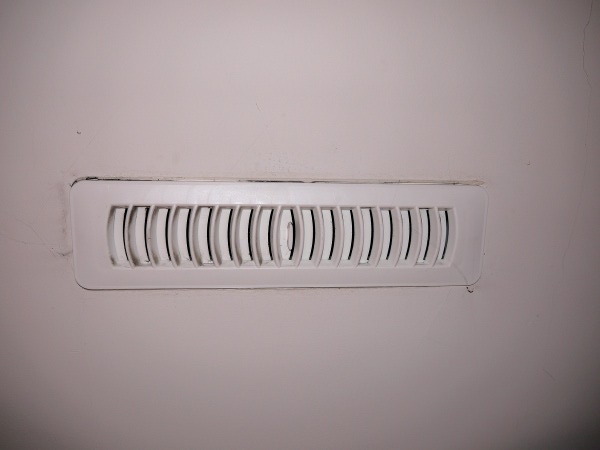
Forced air vent in the ceiling looks suspicious, let's take it off.
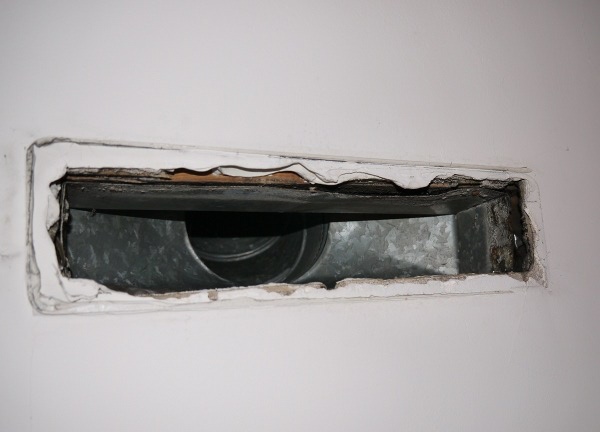
The duct sits loose in a much too big opening.
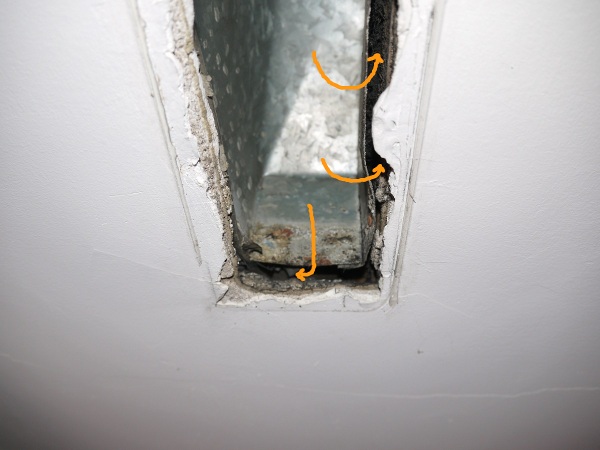
Pressurized air from the duct will not only come down into the room. About 10% will leak up into the attic (yellow arrows).
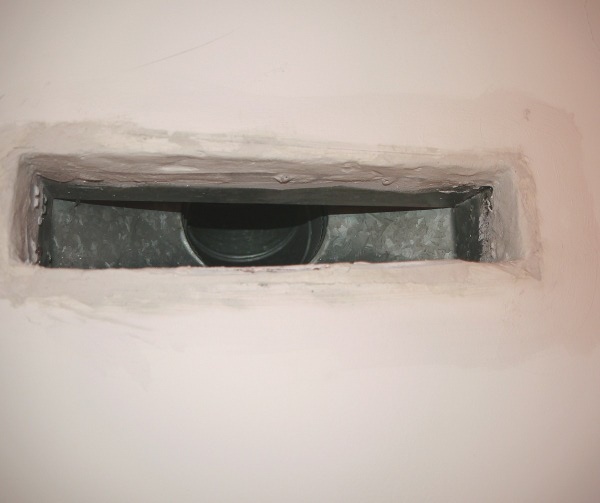
Proper duct installation: close all the gaps.
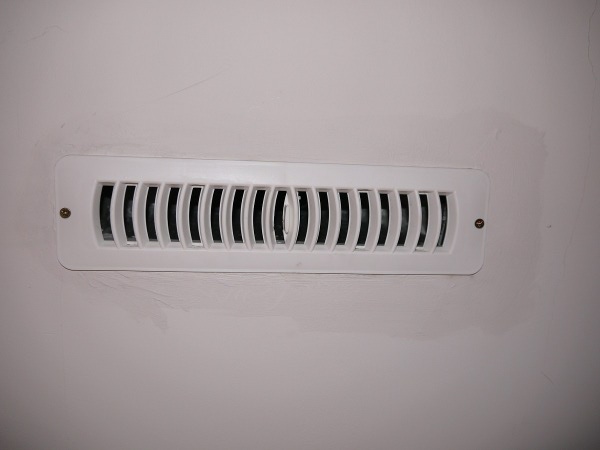
The cover is back on and mounted properly.
Icicles and ice dams because of the sun?
The sun could melt the snow on your roof and cause ice dams even
when everything else is working perfectly.
The sunny winter days in Canada
are usually the coldest. It is the dry air from the north that
pushes away the clouds during the winters in Canada and it is
therefore very cold during those sunny days.
You will not get icicles in very cold weather but on a warm winter day (still below 0'C, let's say -7'C) you
could still get icicles with a bit of sunshine even if there is no problem with the roof. Those will show up
on the south or south-west side of your roof and they will be small. It is impossible to
avoid simply because the sun can provide enough heat to melt snow. However there will
not be much of an ice damm and the icicles will only be a few inches long.
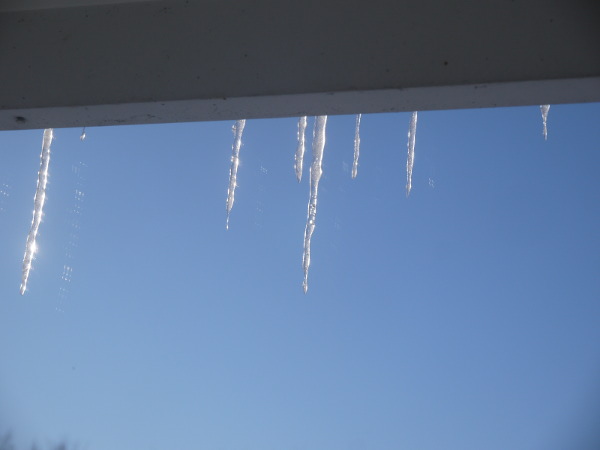
It is possible to get small icicles because of the sun. This is normal.
Professionals at work: a damaged vapor barrier
Here is an example of what can happen when "professionals" renovate a bath
room. For water to flow smoothly without gurgling, there must be an air
passageway behind the water. Vent pipes going up to the roof provide
that passage.
Contractors replaced in this case some of the pipes and attached a new pipe to the
drain-waste-vent. To do this they cut a whole in the wall and bath room
ceiling to attach to the vent pipe that goes out onto the roof. The
ceiling in the bath room was closed but the section that is below
the side wall of the bath room was never closed again. "Insulation"
material was put back in but warm air can now raise from the house
below into the attic through the fluffy insulation material.

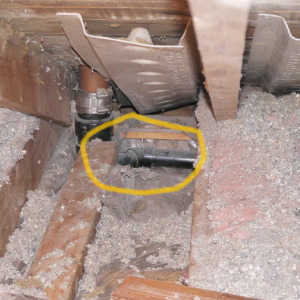
Pict1: snow melts on top of the roof because of a hole in the attic floor that allows warm air to raise through the insulation material into the attic. Pict2: The area marked in yellow is a hole in the attic that leads directly to the inside of the wall in the room below. The horizontal pipe you see in the photo is running in the wall below the attic.
The fix is simple: seal this hole and make sure it is air tight. It's however a lot of detective work that
is required to find the cause and it takes a while to dig-up all that fluffy insulation material to find the
pipe and the hole.
When you plan to renovate an upper bath room then speak to the contractors to see if they understand
the importance of sealing any thing that goes up into the attic. Don't just assume that an experienced
contractor will know what to do. You might just be talking to a repeat offender.
Do I have an ice dam problem?
The ice dam itself is not a problem if it is not too heavy for your gutters and if the roof does
not leak. The only thing you can see during the winter is the icicles and possibly the ice dam
itself unless it is covered in snow. Small icicles are possibly normal and it is not easy to say how
long they can be until it becomes a problem because it depends on the type of roof that you have.
Here are some icicles telling me that this house has an ice dam which is several inches high.


Icicles of this size are and indication that this roof has a big ice dam at the edge of the roof
However it depends on the roof: If you have shingles then an ice dam with icicles as shown above will
cause water to leak into the house when all of the snow melts. If you have a metal roof with a good
underlay then it might not cause any water leakage.
As stated earlier you can try to find a "warm" day (around 0 'C) in early winter or late spring with about 1 inch of snow and
then you might be able to see areas of heat loss. Here is what it looks like for the above house. The pattern you
see is very suspicious. In the center you have a large area where the snow melts. It's probably the result of some
renovation work where the vapor barrier and insulation were damaged. Often the installation of new ceiling lights
or simply running additional cables during renovations is causing such problems. Most of the contractors put what they consider insulation back after
working on the ceiling but they do usually forget the polyethylene foil between ceiling and insulation material.
This foil, the vapor barrier, is absolutely critical. It stops warm humid air from getting into the attic (it's like a draft stop). The insulation is almost useless without that foil but very few contractors seem to know that.
Ceiling lights penetrate deep into the attic and should be covered by an air tight wooden box. Wooden boxes should be wrapped in vapor barrier but there are as well pre-made plastic boxes that are meant to cover ceiling lights inside the attic.
You can see very well that there is no general problem with this roof. The insulation and ventilation to the right seems to be perfect it's just a few spots in the center and to the left. These problems can be fixed by checking the attic in those areas.
Often it is just a matter of repairing the vapor barrier with a special permanent tape that sticks well to polyethylene.
Such a "heat loss picture" is very helpful because it shows the exact location of the problem.
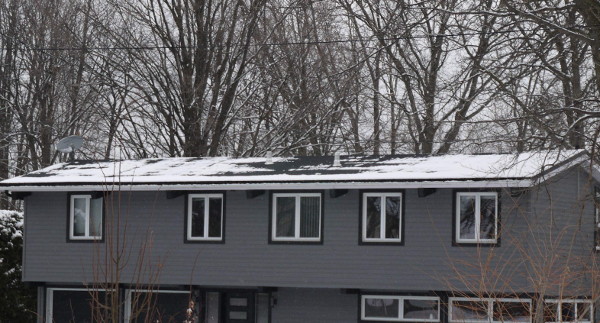
Heat loss pattern for the house with the long icicles.
How about putting a membrane under the roof shingles?
A strong foil such as "grace ice and water shield" or "resisto waterproofing membrane" is always
an extra protection and it is a good idea but the foils come in roles of a fixed width.
Water can eventually get behind the foil. Remember as well that
all the nails holding the shingles will go through the foil and
damage it a bit. Those special foils have some kind of asphalt glue
on the underside and it will seal the area around nails but
after a number of years the glue will get brittle.
It is always good to
fix the root cause of the problem. Remove the cause of the ice dam
and use "grace ice and water shield/resisto waterproofing membrane" in addition.
Air seal before you insulate
Here is a nice video that explains the problem very well:
https://www.youtube.com/watch?v=fB6CbJsb1FM, Attic Insulation Done Wrong... and How to Do It Right!
The house in the video does not have a plastic foil on the attic floor. Most modern houses will have a plastic foil
below the rafters on the attic floor and that is what stops the draft from the house into the attic. In the video they
seal all the gaps but don't add a plastic foil because that foil would have to go below the rafters of the attic floor and it is not possible to retrofit it. If you have a plastic foil in your house then make sure it is continuous and has no holes (fix holes with tape). If there is no plastic foil then seal all the gaps as shown in the video.
It is a good idea to take a picture of the snow melt pattern on your roof. You get the most visible pattern in the fall or in spring when there is only about 1 inch of snow on the roof. If your roof has only certain spots with with heat leaks then you don't have to take out all the insulation in the entire attic. You can take that photo of the snow melt pattern to guide you to the areas where you have to do the air sealing.
© 2004-2025 Guido Socher






